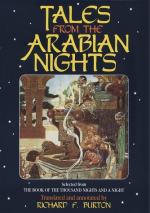[FN#44] Looking glasses in the East are mostly made, like our travelling mirrors, to open and shut.
[FN#45] In Eastern countries the oarsman stands to his work and lessens his labour by applying his weight which cannot be done so forcibly when sitting even upon the sliding-seat. In rowing as in swimming we have forsaken the old custom and have lost instead of gaining.
[FN#46] I have explained this word in vol. iii. 100; viii. 51, etc., and may add the interpretation of Mr. L. C. Casartelli (p. 17) “La Philosophie Religieuse du Mazdeisme, etc., Paris Maisonneuve, 1884.” “A divine name, which has succeeded little (?) is the ancient title Bagh, the O. P. Baga of the Cuneiforms (Baga vazraka Auramazda, etc.) and the Bagha of the Avesta, whose memory is preserved in Baghdad—the city created by the Gods (?). The Pahlevi books show the word in the compound Baghobakht, lit. = what is granted by the Gods, popularly, Providence.”
[FN#47] The H. V. makes the old woman a “finished procuress whose skill was unrivalled in that profession.”
[FN#48] In the text “Al-Sadi w’al-Ghadi:” the latter may mean those who came for the morning meal.
[FN#49] An antistes, a leader in prayer (vols. ii. 203, and iv. 227); a reverend, against whom the normal skit is directed. The H. V. makes him a Muezzin, also a Mosque-man; and changes his name to Murad. Imam is a word with a host of meanings, e.g., model (and master), a Sir-Oracle, the Caliph, etc., etc.
[FN#50] i.e. being neighbours they would become to a certain extent answerable for the crimes committed within the quarter.
[FN#51] Arab. “Nakshat” and “Sifrat.”
[FN#52] Arab. “Farajiyah,” for which see vol. i. 210, 321.
[FN#53] For this aphrodisiac see vol. vi. 60.
[FN#54] In the text “Ay ni’am,” still a popular expression.
[FN#55] Arab. “’Ilm al-Hiah,” gen. translated Astrology, but here meaning scientific Physiognomy. All these branches of science, including Palmistry, are nearly connected; the features and the fingers, mounts, lines, etc. being referred to the sun, moon and planets.
[FN#56] Arab. “Mihaffah bi-takhtrawan”: see vols. ii. 180; v. 175.
[FN#57] The H. V. is more explicit: “do not so, or the King of the Jann will slay thee even before thou canst enjoy her and will carry her away.”
[FN#58] Arab. “Shahwah” the rawest and most direct term. The Moslem religious has no absurd shame of this natural passion. I have heard of a Persian Imam, who, suddenly excited as he was sleeping in a friend’s house, awoke the master with, “Shahwah daram” = “I am lustful” and was at once gratified by a “Mut’ah,” temporary and extempore marriage to one of the slave-girls. These morganatic marriages are not, I may note, allowed to the Sunnis.
[FN#59] Arab. “Min ba’di an” for “Min ba’di ma” = after that, still popular in the latter broad form.




